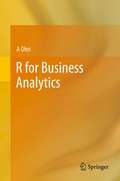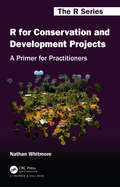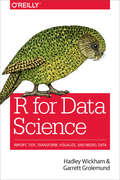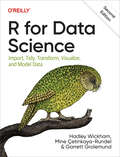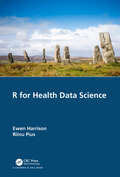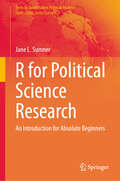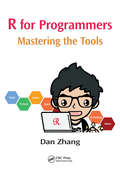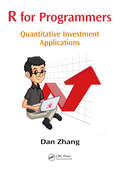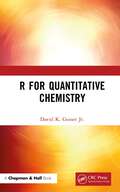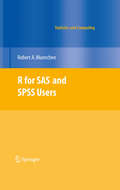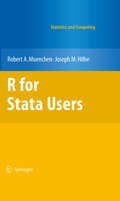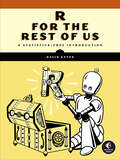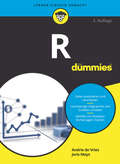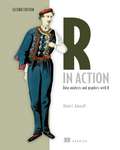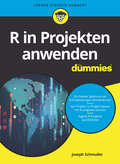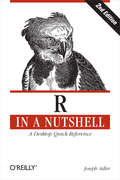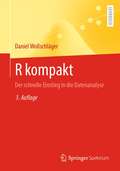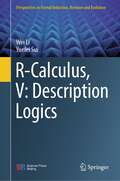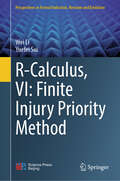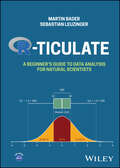- Table View
- List View
R for Business Analytics
by A OhriR for Business Analytics looks at some of the most common tasks performed by business analysts and helps the user navigate the wealth of information in R and its 4000 packages. With this information the reader can select the packages that can help process the analytical tasks with minimum effort and maximum usefulness. The use of Graphical User Interfaces (GUI) is emphasized in this book to further cut down and bend the famous learning curve in learning R. This book is aimed to help you kick-start with analytics including chapters on data visualization, code examples on web analytics and social media analytics, clustering, regression models, text mining, data mining models and forecasting. The book tries to expose the reader to a breadth of business analytics topics without burying the user in needless depth. The included references and links allow the reader to pursue business analytics topics. This book is aimed at business analysts with basic programming skills for using R for Business Analytics. Note the scope of the book is neither statistical theory nor graduate level research for statistics, but rather it is for business analytics practitioners. Business analytics (BA) refers to the field of exploration and investigation of data generated by businesses. Business Intelligence (BI) is the seamless dissemination of information through the organization, which primarily involves business metrics both past and current for the use of decision support in businesses. Data Mining (DM) is the process of discovering new patterns from large data using algorithms and statistical methods. To differentiate between the three, BI is mostly current reports, BA is models to predict and strategize and DM matches patterns in big data. The R statistical software is the fastest growing analytics platform in the world, and is established in both academia and corporations for robustness, reliability and accuracy. The book utilizes Albert Einstein's famous remarks on making things as simple as possible, but no simpler. This book will blow the last remaining doubts in your mind about using R in your business environment. Even non-technical users will enjoy the easy-to-use examples. The interviews with creators and corporate users of R make the book very readable. The author firmly believes Isaac Asimov was a better writer in spreading science than any textbook or journal author.
R for Conservation and Development Projects: A Primer for Practitioners (Chapman & Hall/CRC The R Series)
by Nathan WhitmoreThis book is aimed at conservation and development practitioners who need to learn and use R in a part-time professional context. It gives people with a non-technical background a set of skills to graph, map, and model in R. It also provides background on data integration in project management and covers fundamental statistical concepts. The book aims to demystify R and give practitioners the confidence to use it. Key Features:• Viewing data science as part of a greater knowledge and decision making system • Foundation sections on inference, evidence, and data integration • Plain English explanations of R functions • Relatable examples which are typical of activities undertaken by conservation and development organisations in the developing world • Worked examples showing how data analysis can be incorporated into project reports
R for Data Science: Import, Tidy, Transform, Visualize, and Model Data
by Garrett Grolemund Hadley WickhamLearn how to use R to turn raw data into insight, knowledge, and understanding. This book introduces you to R, RStudio, and the tidyverse, a collection of R packages designed to work together to make data science fast, fluent, and fun. Suitable for readers with no previous programming experience, R for Data Science is designed to get you doing data science as quickly as possible.Authors Hadley Wickham and Garrett Grolemund guide you through the steps of importing, wrangling, exploring, and modeling your data and communicating the results. You’ll get a complete, big-picture understanding of the data science cycle, along with basic tools you need to manage the details. Each section of the book is paired with exercises to help you practice what you’ve learned along the way.You’ll learn how to:Wrangle—transform your datasets into a form convenient for analysisProgram—learn powerful R tools for solving data problems with greater clarity and easeExplore—examine your data, generate hypotheses, and quickly test themModel—provide a low-dimensional summary that captures true "signals" in your datasetCommunicate—learn R Markdown for integrating prose, code, and results
R for Data Science: Import, Tidy, Transform, Visualize, and Model Data
by Garrett Grolemund Hadley Wickham Mine Çetinkaya-RundelUse R to turn data into insight, knowledge, and understanding. With this practical book, aspiring data scientists will learn how to do data science with R and RStudio, along with the tidyverse—a collection of R packages designed to work together to make data science fast, fluent, and fun. Even if you have no programming experience, this updated edition will have you doing data science quickly.You'll learn how to import, transform, and visualize your data and communicate the results. And you'll get a complete, big-picture understanding of the data science cycle and the basic tools you need to manage the details. Updated for the latest tidyverse features and best practices, new chapters show you how to get data from spreadsheets, databases, and websites. Exercises help you practice what you've learned along the way.You'll understand how to:Visualize: Create plots for data exploration and communication of resultsTransform: Discover variable types and the tools to work with themImport: Get data into R and in a form convenient for analysisProgram: Learn R tools for solving data problems with greater clarity and easeCommunicate: Integrate prose, code, and results with Quarto
R for Health Data Science
by Ewen Harrison Riinu PiusIn this age of information, the manipulation, analysis, and interpretation of data have become a fundamental part of professional life; nowhere more so than in the delivery of healthcare. From the understanding of disease and the development of new treatments, to the diagnosis and management of individual patients, the use of data and technology is now an integral part of the business of healthcare. Those working in healthcare interact daily with data, often without realising it. The conversion of this avalanche of information to useful knowledge is essential for high-quality patient care. R for Health Data Science includes everything a healthcare professional needs to go from R novice to R guru. By the end of this book, you will be taking a sophisticated approach to health data science with beautiful visualisations, elegant tables, and nuanced analyses. Features Provides an introduction to the fundamentals of R for healthcare professionals Highlights the most popular statistical approaches to health data science Written to be as accessible as possible with minimal mathematics Emphasises the importance of truly understanding the underlying data through the use of plots Includes numerous examples that can be adapted for your own data Helps you create publishable documents and collaborate across teams With this book, you are in safe hands – Prof. Harrison is a clinician and Dr. Pius is a data scientist, bringing 25 years’ combined experience of using R at the coal face. This content has been taught to hundreds of individuals from a variety of backgrounds, from rank beginners to experts moving to R from other platforms.
R for Health Technology Assessment (Chapman & Hall/CRC Biostatistics Series)
by Gianluca Baio Howard Thom Petros PechlivanoglouR for Health Technology Assessment discusses the use of proper statistical software, specifically R, to perform the whole pipeline of analytic modelling in health technology assessment (HTA). It has been designed with the objective of establishing the use of R as the standard tool for HTA amongst academics, industry practitioners and regulators. It covers a lot of ground, starting with the necessary background in HTA, R and statistical inference, followed by various modelling tools, ranging from missing data, survival analysis and decision trees, through to multistate models and discrete event simulation. The methods are all illustrated with many detailed worked examples and case studies using real data, and there are detailed descriptions of the code and processes.Key Features: Introductory chapters on the various topics of the book, including HTA, R and statistical inference A wide range of common analytical tools used in HTA, from modelling for individual-level data, missing data, survival analysis, decision-modelling and network meta-analysis More advanced and increasingly popular tools, such as those for population adjustment, discrete event simulation and the use of web applications as front-end for the overall statistical modelling Many detailed worked examples and case studies using real data to illustrate the methodology Fully integrated R code gives detailed guidance on implementation of the techniques Supplemented by a website with additional resources, including annotated code and data This text is primarily aimed at modellers working in the field of HTA, regulators and reviewers of reimbursement dossiers and cost-effectiveness analyses. It also complements a wide range of undergraduate and graduate programmes in HTA, health and public health economics, as well as academic researchers in the field of statistical modelling for HTA.
R for Non-Programmers
by Daniel DauberUnlock the Power of Data Analysis with RWhether you are a researcher, student, or professional new to programming, this book provides a step-by-step guide to mastering R for quantitative and mixed-methods analysis. Designed for those who still need to gain program- ming experience or wish to learn a new one, it demystifies data analysis, helping you tackle challenges from data wrangling to statistical modelling. Packed with practical examples, engaging explanations, and real-world applications, this book equips you with the tools to analyse data confidently, identify trends, and uncover meaningful insights.Transform Your Approach to ResearchThrough clear instructions and hands-on exercises, you will learn to prepare datasets, explore patterns with descriptive statistics, and create impactful visualisations. You will also gain confidence in performing statistical tests such as comparing groups and building predictive models using regression techniques. This book provides strategies and tools to streamline your workflow, whether handling large datasets, managing missing data, or conducting mixed-methods research.Each chapter builds your expertise incrementally, supported by accessible examples and interactive online training. The accompanying training modules, available through the book’s companion package, offer engaging exercises and extended examples to reinforce learning. These features enable you to practise skills and retain knowledge more effectively.This book, which strongly focuses on reproducible research, is an indispensable guide for anyone looking to enhance their analytical toolkit and unlock R’s full potential for data analysis and statistical modelling.
R for Political Science Research: An Introduction for Absolute Beginners (Texts in Quantitative Political Analysis)
by Jane L. SumnerThis text teaches basic R skills to political science students with no programming background. Intended specifically for the students who need to learn R for a class and who have no interest in R or may even be afraid of or hostile to it, this text builds an awareness of basics, confidence, and a skill set necessary to transition into more advanced texts. To that end, in addition to standard topics, this book includes three chapters specific to the new or reluctant learner. The Introduction explicitly sets expectations for how to use the book and discusses fixed and growth mentalities, and why a growth mentality is crucial for learning R. Chapter 1 includes some basic information on programming, R, and their place in political science research. Chapter 2 explicitly discusses errors, warnings, and methods of debugging. Further chapters build on this by including new errors or warnings that students may encounter as they progress. In service of the aim to give students a solid foundation in R and awareness of what it is and can do, this book teaches and uses both tidyverse and base R frameworks throughout. After completing the book, students should be prepared to learn more advanced materials.
R for Programmers: Advanced Techniques
by Dan ZhangThis book discusses advanced topics such as R core programing, object oriented R programing, parallel computing with R, and spatial data types. The author leads readers to merge mature and effective methdologies in traditional programing to R programing. It shows how to interface R with C, Java, and other popular programing laguages and platforms.
R for Programmers: Mastering the Tools
by Dan ZhangUnlike other books about R, written from the perspective of statistics, this book is written from the perspective of programmers, providing a channel for programmers with expertise in other programming languages to quickly understand R. The contents are divided into four parts: the basics of R, the server of R, databases and big data, and the appendices, which introduce the installation of Java, various databases, and Hadoop. Because this is a reference book, there is no special sequence for reading all the chapters. Anyone new to the subject who wishes to master R comprehensively can simply follow the chapters in sequence.
R for Programmers: Quantitative Investment Applications
by Dan ZhangAfter the fundamental volume and the advanced technique volume, this volume focuses on R applications in the quantitative investment area. Quantitative investment has been hot for some years, and there are more and more startups working on it, combined with many other internet communities and business models. R is widely used in this area, and can be a very powerful tool. The author introduces R applications with cases from his own startup, covering topics like portfolio optimization and risk management.
R for Quantitative Chemistry
by David K. GosserR for Quantitative Chemistry is an exploration of how the R language can be applied to a wide variety of problems in what is typically termed "Quantitative Chemistry" or sometimes "Analytical Chemistry". Topics include: basic statistics, spectroscopic data, acid base equilibria and titrations, binding curves (of great current interest for biomedical applications), Fourier Transforms, and chemical kinetics and enzyme kinetics. An innovative feature is the discussion (as an alternative to the less stable nls packages) of the simplex adaptation subplex (R package) coupled with Monte Carlo analysis to determine confidence intervals for estimated parameters resulting from least squares optimization. Chemists who are interested in learning R as a research tool as well as Chemists who are teaching Quantitative Chemistry, as well as their students will be interested. This book is useful as most R books approach data analysis from an economic, social, medical, or biological context. Analysis of chemical data draws upon specific numerical models and a different set R programming and packages than is typically discussed in other disciplines. This book will be based upon, in large part, actual experimental data and will include end of chapter questions and projects. Readers are encouraged to email the author at gosserch@gmail.com and to follow the accompanying blog on Medium "R Programming for Quantitative Chemistry". Key Features: Elements of R programming for Chemists Literature Based Examples Includes Binding Assay Analysis Integrates theory, experiment, and R programming
R for SAS and SPSS Users
by Robert A. MuenchenThis book introduces R using SAS and SPSS terms. It demonstrates which of the add-on packages are most like SAS and SPSS and compares them to R's built-in functions. It compares and contrasts the differing approaches of all three packages.
R for Stata Users
by Robert A. Muenchen Joseph M. HilbeStata is the most flexible and extensible data analysis package available from a commercial vendor. R is a similarly flexible free and open source package for data analysis, with over 3,000 add-on packages available. This book shows you how to extend the power of Stata through the use of R. It introduces R using Stata terminology with which you are already familiar. It steps through more than 30 programs written in both languages, comparing and contrasting the two packages' different approaches. When finished, you will be able to use R in conjunction with Stata, or separately, to import data, manage and transform it, create publication quality graphics, and perform basic statistical analyses. A glossary defines over 50 R terms using Stata jargon and again using more formal R terminology. The table of contents and index allow you to find equivalent R functions by looking up Stata commands and vice versa. The example programs and practice datasets for both R and Stata are available for download.
R for Statistics
by Pierre-Andre Cornillon Francois Husson Arnaud Guyader Nicolas Jegou Julie Josse Maela Kloareg Eric Matzner-Lober Laurent RouvièreAlthough there are currently a wide variety of software packages suitable for the modern statistician, R has the triple advantage of being comprehensive, widespread, and free. Published in 2008, the second edition of Statistiques avec R enjoyed great success as an R guidebook in the French-speaking world. Translated and updated, R for Statistics in
R for the Rest of Us: A Statistics-Free Introduction
by David KeyesLearn how to use R for everything from workload automation and creating online reports, to interpreting data, map making, and more.Written by the founder of a very popular online training platform for the R programming language!The R programming language is a remarkably powerful tool for data analysis and visualization, but its steep learning curve can be intimidating for some. If you just want to automate repetitive tasks or visualize your data, without the need for complex math, R for the Rest of Us is for you.Inside you&’ll find a crash course in R, a quick tour of the RStudio programming environment, and a collection of real-world applications that you can put to use right away. You&’ll learn how to create informative visualizations, streamline report generation, and develop interactive websites—whether you&’re a seasoned R user or have never written a line of R code.You&’ll also learn how to:• Manipulate, clean, and parse your data with tidyverse packages like dplyr and tidyr to make data science operations more user-friendly• Create stunning and customized plots, graphs, and charts with ggplot2 to effectively communicate your data insights• Import geospatial data and write code to produce visually appealing maps automatically• Generate dynamic reports, presentations, and interactive websites with R Markdown and Quarto that seamlessly integrate code, text, and graphics• Develop custom functions and packages tailored to your specific needs, allowing you to extend R&’s functionality and automate complex tasksUnlock a treasure trove of techniques to transform the way you work. With R for the Rest of Us, you&’ll discover the power of R to get stuff done. No advanced statistics degree required.
R für Dummies (Für Dummies)
by Joris Meys Andrie de VriesWollen Sie auch die umfangreichen Möglichkeiten von R nutzen, um Ihre Daten zu analysieren, sind sich aber nicht sicher, ob Sie mit der Programmiersprache wirklich zurechtkommen? Keine Sorge - dieses Buch zeigt Ihnen, wie es geht - selbst wenn Sie keine Vorkenntnisse in der Programmierung oder Statistik haben. Andrie de Vries und Joris Meys zeigen Ihnen Schritt für Schritt und anhand zahlreicher Beispiele, was Sie alles mit R machen können und vor allem wie Sie es machen können. Von den Grundlagen und den ersten Skripten bis hin zu komplexen statistischen Analysen und der Erstellung aussagekräftiger Grafiken. Auch fortgeschrittenere Nutzer finden in diesem Buch viele Tipps und Tricks, die Ihnen die Datenauswertung erleichtern.
R in Action: Data analysis and graphics with R
by Robert I. KabacoffSummaryR in Action, Second Edition presents both the R language and the examples that make it so useful for business developers. Focusing on practical solutions, the book offers a crash course in statistics and covers elegant methods for dealing with messy and incomplete data that are difficult to analyze using traditional methods. You'll also master R's extensive graphical capabilities for exploring and presenting data visually. And this expanded second edition includes new chapters on time series analysis, cluster analysis, and classification methodologies, including decision trees, random forests, and support vector machines.Purchase of the print book includes a free eBook in PDF, Kindle, and ePub formats from Manning Publications.About the TechnologyBusiness pros and researchers thrive on data, and R speaks the language of data analysis. R is a powerful programming language for statistical computing. Unlike general-purpose tools, R provides thousands of modules for solving just about any data-crunching or presentation challenge you're likely to face. R runs on all important platforms and is used by thousands of major corporations and institutions worldwide.About the BookR in Action, Second Edition teaches you how to use the R language by presenting examples relevant to scientific, technical, and business developers. Focusing on practical solutions, the book offers a crash course in statistics, including elegant methods for dealing with messy and incomplete data. You'll also master R's extensive graphical capabilities for exploring and presenting data visually. And this expanded second edition includes new chapters on forecasting, data mining, and dynamic report writing.What's InsideComplete R language tutorialUsing R to manage, analyze, and visualize dataTechniques for debugging programs and creating packagesOOP in ROver 160 graphsAbout the AuthorDr. Rob Kabacoff is a seasoned researcher and teacher who specializes in data analysis. He also maintains the popular Quick-R website at statmethods.net.Table of ContentsPART 1 GETTING STARTEDIntroduction to RCreating a datasetGetting started with graphsBasic data managementAdvanced data managementPART 2 BASIC METHODSBasic graphsBasic statisticsPART 3 INTERMEDIATE METHODSRegressionAnalysis of variancePower analysisIntermediate graphsResampling statistics and bootstrappingPART 4 ADVANCED METHODSGeneralized linear modelsPrincipal components and factor analysisTime seriesCluster analysisClassificationAdvanced methods for missing dataPART 5 EXPANDING YOUR SKILLSAdvanced graphics with ggplot2Advanced programmingCreating a packageCreating dynamic reportsAdvanced graphics with the lattice package available online only from manning.com/kabacoff2
R in Projekten anwenden für Dummies (Für Dummies)
by Joseph SchmullerDieses Buch bietet einen einzigartigen Learning-by-Doing-Ansatz. Sie werden Ihre R-Fähigkeiten erweitern und vertiefen, indem Sie eine Vielzahl von Beispielprojekten aus der Praxis nachvollziehen. Erlernen Sie die Grundlagen von R und RStudio sowie Möglichkeiten der Datenreduktion, des Mapping und der Bildverarbeitung. Dabei kommen Werkzeuge zum Einsatz, die Daten grafisch auswerten, die Analyse interaktiv machen oder die maschinelles Lernen einsetzen. Und auf dem Weg dahin können Sie sogar Ihr Statistikwissen noch erweitern. Warum sollten Sie das Rad neu erfinden, wenn es schon fertige R-Pakete gibt, die Ihre Bedürfnisse bedienen? Hier lernen Sie sie kennen.
R in a Nutshell: A Desktop Quick Reference
by Joseph AdlerIf you’re considering R for statistical computing and data visualization, this book provides a quick and practical guide to just about everything you can do with the open source R language and software environment. You’ll learn how to write R functions and use R packages to help you prepare, visualize, and analyze data. Author Joseph Adler illustrates each process with a wealth of examples from medicine, business, and sports.Updated for R 2.14 and 2.15, this second edition includes new and expanded chapters on R performance, the ggplot2 data visualization package, and parallel R computing with Hadoop.Get started quickly with an R tutorial and hundreds of examplesExplore R syntax, objects, and other language detailsFind thousands of user-contributed R packages online, including BioconductorLearn how to use R to prepare data for analysisVisualize your data with R’s graphics, lattice, and ggplot2 packagesUse R to calculate statistical fests, fit models, and compute probability distributionsSpeed up intensive computations by writing parallel R programs for HadoopGet a complete desktop reference to R
R kompakt: Der schnelle Einstieg in die Datenanalyse
by Daniel WollschlägerDieses Buch bietet eine kompakte Einführung in die Datenauswertung mit der freien Statistikumgebung R. Ziel ist es dabei, einen Überblick über die Funktionalität von R zu liefern und einen schnellen Einstieg in die deskriptive Datenauswertung sowie in die Umsetzung der wichtigsten statistischen Tests zu ermöglichen. Zudem deckt das Buch die vielfältigen Möglichkeiten ab, Diagramme zu erstellen, Daten mit anderen Programmen auszutauschen und R durch Zusatzpakete zu erweitern. Das Buch ist damit für Leser geeignet, die R kennenlernen und rasch in konkreten Aufgabenstellungen einsetzen möchten.Für die 3. Auflage wurde das Buch grundlegend überarbeitet und auf Neuerungen der R Version 4.1.0 sowie der aktuellen Landschaft der Zusatzpakete abgestimmt. Mit einer stärkeren Ausrichtung auf Data Science Anwendungen stellt das Buch nun ausführlich die Pakete dplyr zur Datenaufbereitung und ggplot2 für Diagramme vor. Darüber hinaus enthält das Buch eine Darstellung von dynamischen R Markdown Dokumenten zur Unterstützung reproduzierbarer Auswertungen.
R-Calculus, V: Description Logics (Perspectives in Formal Induction, Revision and Evolution)
by Wei Li Yuefei SuiThis book series consists of two parts, decidable description logics and undecidable description logics. It gives the R-calculi for description logics. This book offers a rich blend of theory and practice. It is suitable for students, researchers and practitioners in the field of logic.
R-Calculus, VI: Finite Injury Priority Method (Perspectives in Formal Induction, Revision and Evolution)
by Wei Li Yuefei SuiThis sixth volume of the book series applies finite injury priority method to R-calculi and obtain (in)completeness theorem for binary-valued, Post three-valued, B2^2-valued and L4-valued first-order logics, and extend the method to infinite injury priority method and 0"-method for default logic to produce pseudo-extensions of a default theory, corresponding to different R-calculi. Finite injury priority method and tree constructions are discussed in this book. This book offers a rich blend of theory and practice. It is suitable for students, researchers and practitioners in the field of logic.
R-ticulate: A Beginner's Guide to Data Analysis for Natural Scientists
by Martin Bader Sebastian LeuzingerAn accessible learning resource that develops data analysis skills for natural science students in an efficient style using the R programming language R-ticulate: A Beginner’s Guide to Data Analysis for Natural Scientists is a compact, example-based, and user-friendly statistics textbook without unnecessary frills, but instead filled with engaging, relatable examples, practical tips, online exercises, resources, and references to extensions, all on a level that follows contemporary curricula taught in large parts of the world. The content structure is unique in the sense that statistical skills are introduced at the same time as software (programming) skills in R. This is by far the best way of teaching from the authors’ experience. Readers of this introductory text will find: Explanations of statistical concepts in simple, easy-to-understand language A variety of approaches to problem solving using both base R and tidyverse Boxes dedicated to specific topics and margin text that summarizes key points A clearly outlined schedule organized into 12 chapters corresponding to the 12 semester weeks of most universities While at its core a traditional printed book, R-ticulate: A Beginner’s Guide to Data Analysis for Natural Scientists comes with a wealth of online teaching material, making it an ideal and efficient reference for students who wish to gain a thorough understanding of the subject, as well as for instructors teaching related courses.
R. Edward Freeman’s Selected Works on Stakeholder Theory and Business Ethics (Issues in Business Ethics #53)
by R. Edward Freeman Sergiy D. DmytriyevEd Freeman’s influential ideas on stakeholder theory, business ethics, humanities, and capitalism became foundational in the management field and turned around the mainstream thinking about business. Stakeholder theory developed by Freeman and others posits that business is not as much about profits, but rather about creating value for its stakeholders, including employees, customers, communities, financiers, and suppliers. The relationship between a company and its stakeholders is the essence of business and should be of utmost attention to its managers. Managers should avoid resorting to trade-offs by prioritizing one stakeholder group (e.g., shareholders) over the others and strive to run their companies in the interests of all stakeholders. The idea of pursuing the interests of all stakeholders became revolutionary in management and went far beyond the management field, expanding to Law, Health Care, Education, Public Policy and Administration, and Environmental Policy. This book is a collection of Ed Freeman’s most influential and important works on stakeholder theory as well as business ethics, humanities, and capitalism.
